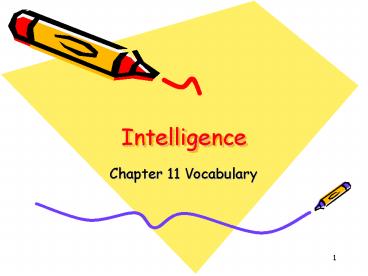Intelligence PowerPoint PPT Presentation
Title: Intelligence
1
Intelligence
- Chapter 11 Vocabulary
2
Intelligence
- Mental quality consisting of the ability to learn
from experience, solve problems, and use
knowledge to adapt to new situations.
3
Factor analysis
- A statistical procedure that identifies clusters
of related items (called factors) on a test used
to identify different dimensions of performance
that underlie one's total score.
4
General intelligence
- A general intelligence factor that according to
Spearman and others underlies specific mental
abilities and is therefore measured by every task
on an intelligence test.
5
Savant Syndrome
- Rain Man
- A condition in which a person otherwise limited
in mental ability has an exceptional specific
skill, such as in computation or drawing. - Matt Savage, Kim Peek, Alonzo Clemons
6
Theories of Intelligence
Theory Summary
Spearmans General Intelligence A Basic intelligence predicts our abilities in varied academic areas
Thurstones primary mental abilities Our intelligence may be broken down into seven factors
Gardners multiple intelligence Our abilities are best classified into eight independent intelligences
Sternbergs Triarchic Our intelligence is best classified into three areas that predict real world success
7
Creativity
- The ability to produce novel and valuable ideas.
8
Intelligence Test
- A method for assessing an individuals mental
aptitudes and comparing them with those of
others, using numerical scores. - So do you believe in intelligence tests? If so
why?
9
Mental Age
- A measure of intelligence test performance
devised by Binet the chronological age that most
typical corresponds to a given level of
performance.
10
Stanford Binet
- The widely used American revision of Binets
original test.
11
Intelligence Quotient
- Defined originally as the ratio of mental age
(ma) to chronological age (ca) multiplied by 100
(thus IQ ma/ca x 100). On contemporary
intelligence tests, the average performance for a
given age is assigned a score of 100
12
Aptitude test
- A Test designed to PREDICT a persons future
performance aptitude is capacity of learning.
13
Achievement Test
- A test designed to assess what a person has
LEARNED.
14
Wechsler Adult Intelligence Scale
- WAIS
- The most widely used intelligence test contains
verbal and performance (nonverbal) subtests.
15
Standardization
- Defining meaningful scores by comparison with
performance of a pretested standardization group.
16
Normal Curve
- The symmetrical bell shaped curve that describes
the distribution of many physical and
psychological attributes.
17
Reliability
- The extent to which a test yields consistent
results, as assessed by the consistency of
scores on two halves of the test, on alternate
forms of the test, or on retesting.
18
Validity
- The extent to which a test measures or predicts
what it is supposed to.
19
Content validity
- The extent to which a test samples the behavior
that is of interest. - Driving test
20
Criterion
- The behavior that a test is designed to predict
thus the measure used in defining whether the
test has predictive validity.
21
Predictive Validity
- The success with which a test predicts the
behavior it is designed to predict it is
assessed by computing the correlation between
test scores and the criterion behavior.
22
Mental Retardation
- A CONDTION OF LIMITED MENTAL ABILITY, INDICATED
BY AN INTELLIGENCE SCORE OF 70 OR BELOW AND
difficulty in adapting to the demands of life
varies from mild to profound.
23
Down Syndrome
- A condition of retardation and associated
physical disorders cause d by an extra chromosome
in ones genetic makeup. - presence of all or part of an extra 21st
chromosome
24
Stereotype Threat
- A self confirming concern that one will be
evaluated based on a negative stereotype.

